From can’t-miss attractions to some lesser-known secrets that you won’t find in guidebooks, this list is packed with the best things to do in Petra. Plus we’re going over everything you need to know to make the most of your visit to the Rose City.
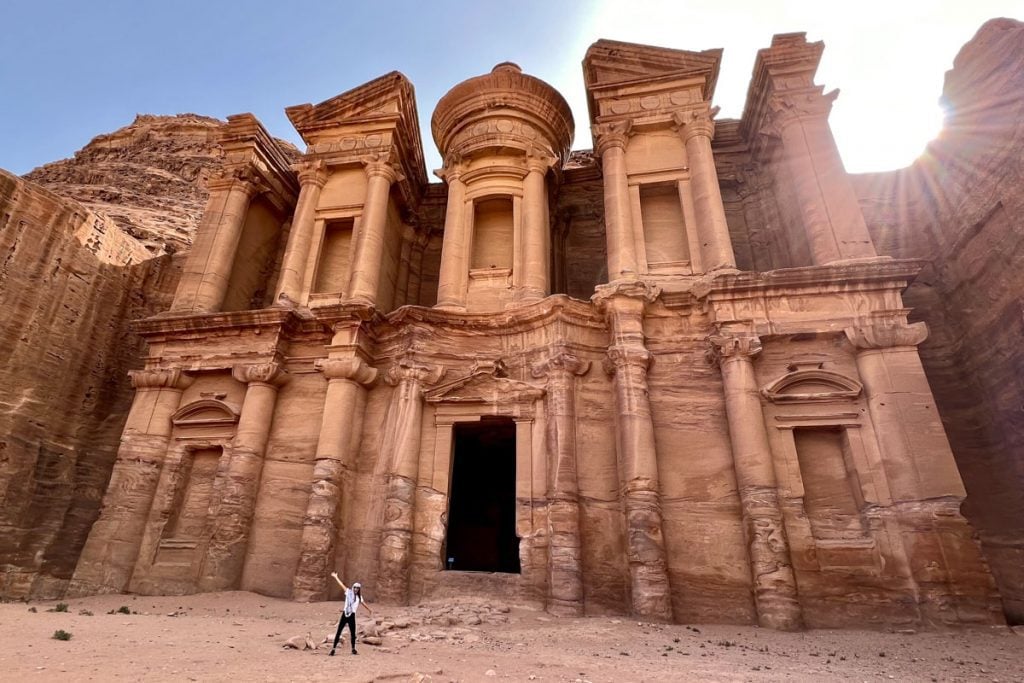
Petra, the “Lost City” and former capital of the Nabataean Kingdom, is Jordan’s crowning jewel of tourist attractions. Once an important trading city with a population of 20,000–30,000 people, the settlement was later abandoned and remained uninhabited for five centuries.
After it was rediscovered in 1812, Petra was later declared a UNESCO World Heritage Site and one of the New Seven Wonders of the World. Today, there’s nothing on Earth quite like this beautiful, ancient city that defies logic and exceeds expectations.
Most tourists in the country come to visit Petra—it’s one of the top things to do in Jordan after all—making it crowded and confusing to navigate. That’s where we come in!
In this article, we’re sharing all the best things to do in Petra; from the famous must-see attractions, to some hidden gems you won’t find in the guidebooks.
We will also cover everything you need to know about visiting Petra, including insider tips to avoid the crowds, how to plan your Petra itinerary and where to stay.
Petra Travel Guide
For more tips and advice for planning your trip to Petra Jordan, jump to the following sections (or just keep scrolling to see it all!).
- Is Petra worth visiting?
- General info
- How to get there
- Cost
- Best time to go
- How many days do you need?
- Petra itinerary planning
- What to wear/pack
- Where to stay
- Roundup of things to do in Petra
Top things to do in Petra
If you’re looking for the very best things to do in Petra on your first visit, here are our top recommendations.
- Photograph The Treasury
- Climb to the High Place of Sacrifice
- Explore the Royal Tombs
- Climb to the Petra Monastery
Keep reading for more detailed information on each of these and more ideas of fun things to do in Petra Archaeological Park and beyond.
1. Photograph the Petra Treasury
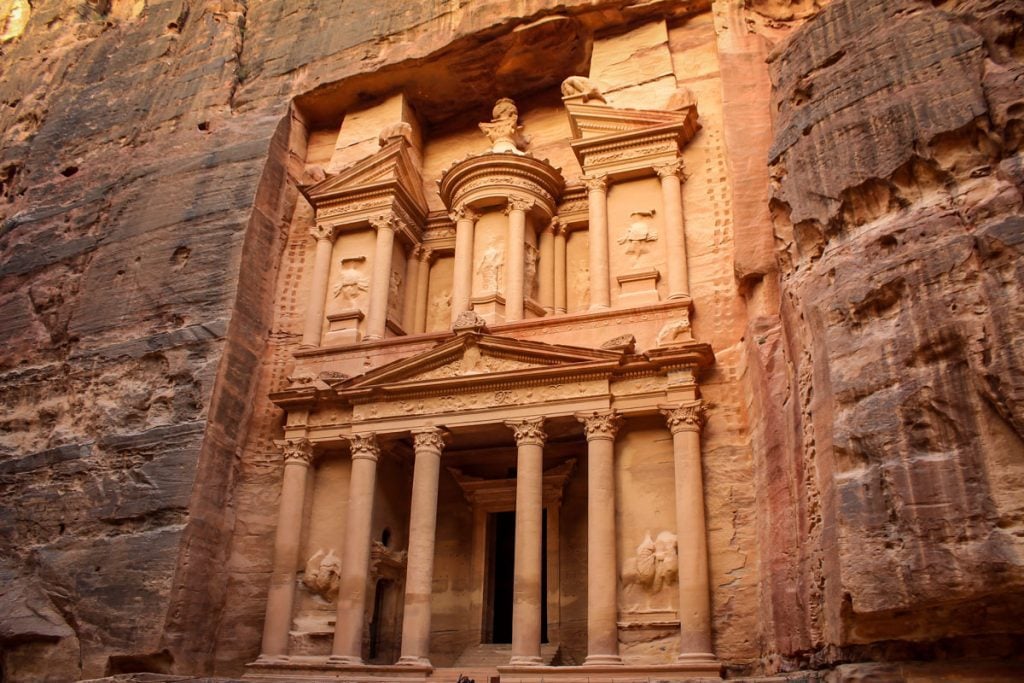
The Treasury, officially called Al Khazneh, is the first major point of interest when you enter Petra, acting as a sentinel guarding the rest of the city. From the entrance, it’s about a 30-minute walk through the canyon before you get your first peek of the Treasury.
Immortalized by Indiana Jones and the Last Crusade, the Treasury is undoubtedly the most famous Petra landmark.
Elaborately ornamented with columns and sculptures, the temple is topped with a funerary urn, typically used to hold ashes. Its specific use during the Nabataean era is unknown (this is the type of thing that makes Petra so fascinating!).
Note that you cannot go inside the Treasury itself, but you should still allow sufficient time to admire the facade, pore over every detail, and take plenty of pictures.
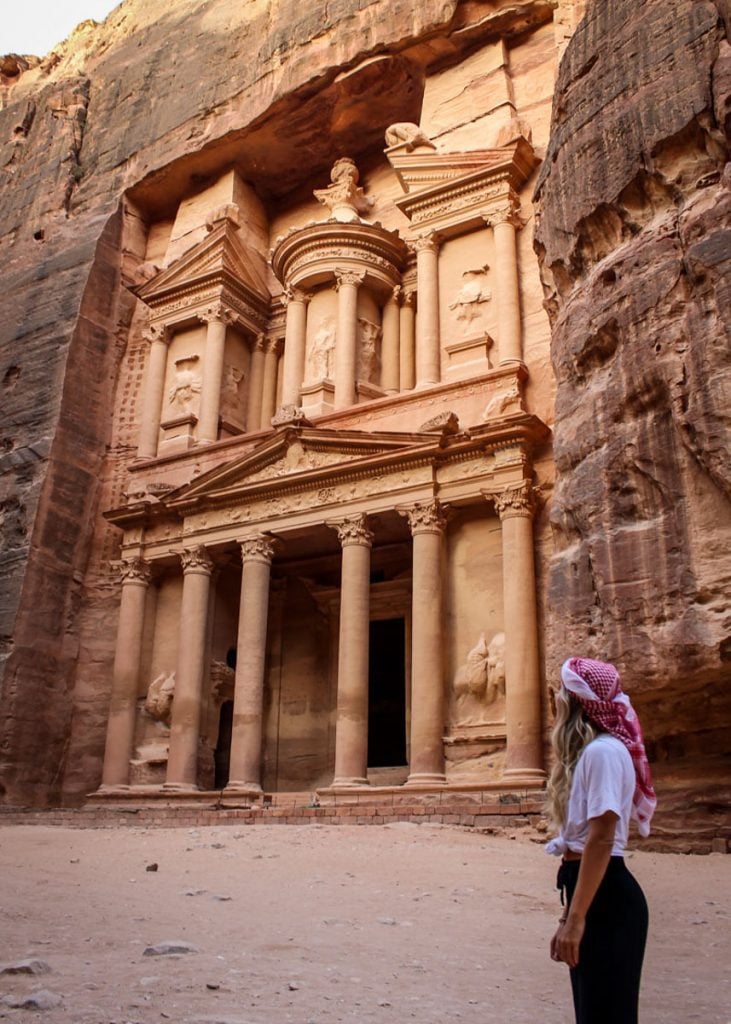
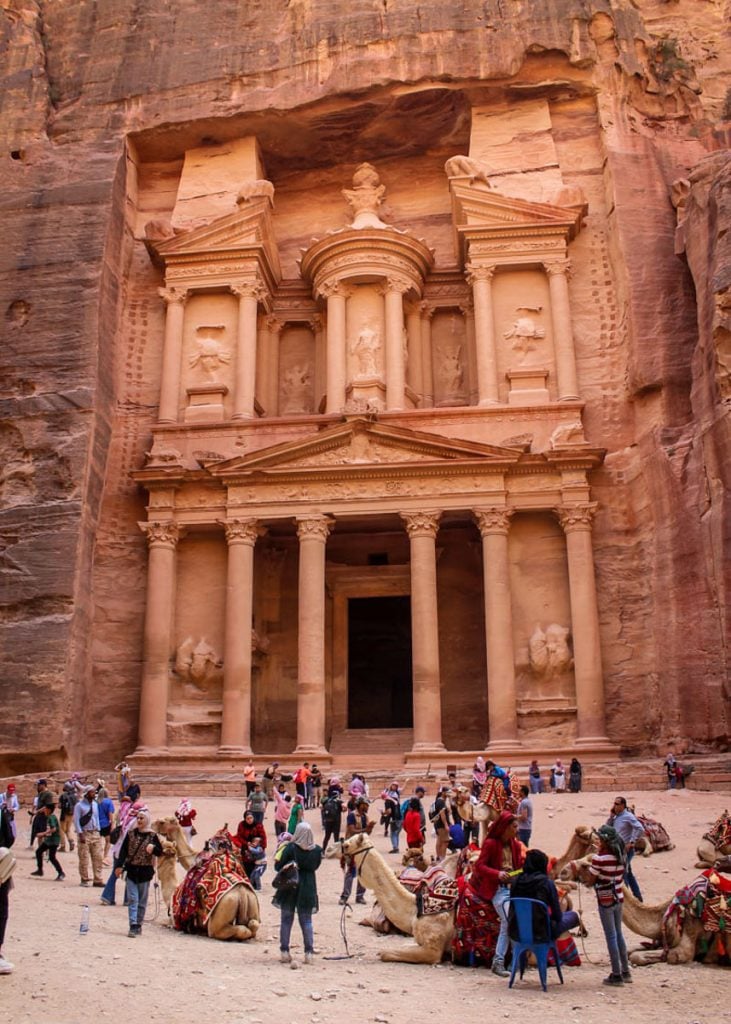
Lighting conditions for photography are best early in the morning and late afternoon into early evening. This is also when the Treasury is at its quietest in terms of crowds, so if possible, plan your visit then.
Insider travel tip: Plan on arriving at the entrance to Petra right at 6:00 a.m. when it opens to have the Treasury mostly to yourself first thing in the morning! You’ll get better photos, without all the crowds.
Note about the guides: While at the Treasury, you’ll run into a lot of Bedouin people (men, mostly) who will approach you and offer to escort you to The High Place. It can feel overwhelming, so the best thing to do is politely but firmly offer a simple “no” or “maybe later.”
A lot of tourists complain about these men, but keep in mind that ultimately, they’re simply trying to make a living. And in my experience, everyone we encountered was quite respectful. They’re not aggressive, just persistent.
Treasury viewpoints
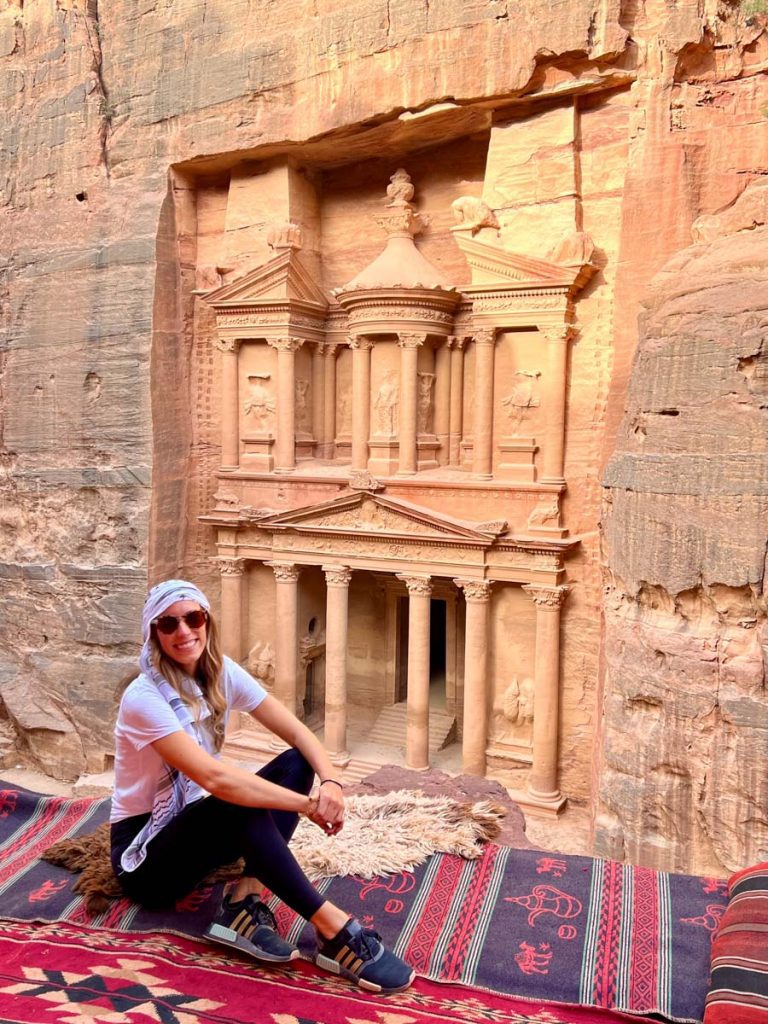
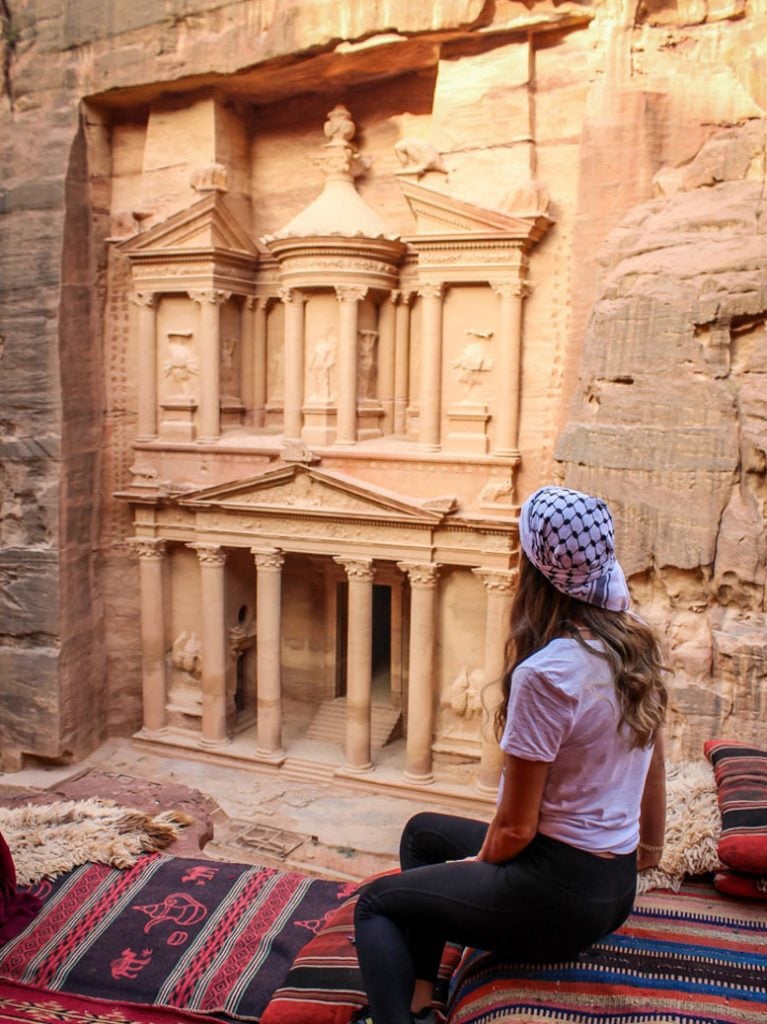
There are actually a few different vantage points setup to view the Treasury from above; each with unique but similar views.
If you want to visit any of the viewing areas above the Treasury, you should expect to pay your Bedouin “guide” around 5 JOD ($7 USD) per person. They’ll likely quote you closer to 15 JOD ($21 USD), but negotiating is common. We were told ahead of time not to pay over 5 JOD and sure enough, our guide accepted that immediately to take us to one of the closer viewing points.
Once at the viewing area, your guide will happily take photos of you and allow you space to soak in the view for as long as you want. Ours was a surprisingly good photographer! There is also usually a man brewing mint tea at the top; bring some extra cash for a cup and to tip him (1 JOD is sufficient).
2. Climb to the High Place of Sacrifice
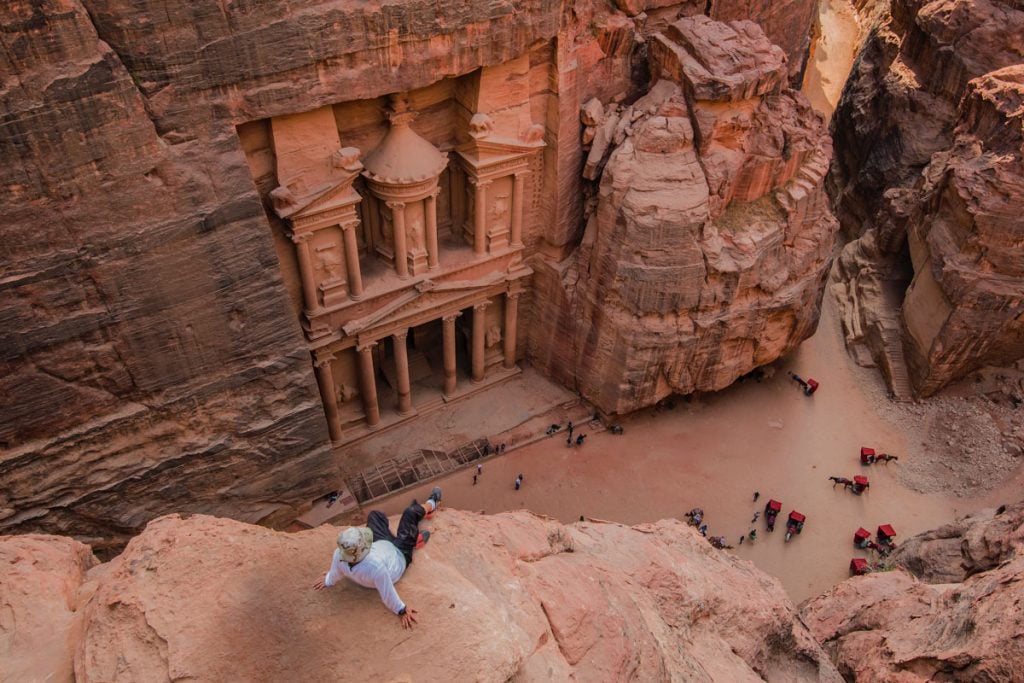
Most commonly known as simply “The High Place,” this is one of the highest points in Petra, offering a vantage point with an incredible — and utterly breathtaking — view and photo op of the Treasury.
Access to The High Place requires a half hour climb up a steep staircase carved into the side of the rock face beginning near the Theater.
While it’s not required to have a guide to visit The High Place, it may be nice for some people to have an escort. And if you don’t want to climb the steps all the way to The High Place, you can choose a shorter climb, which also gives you closer views, like we did.
3. Explore the Royal Tombs
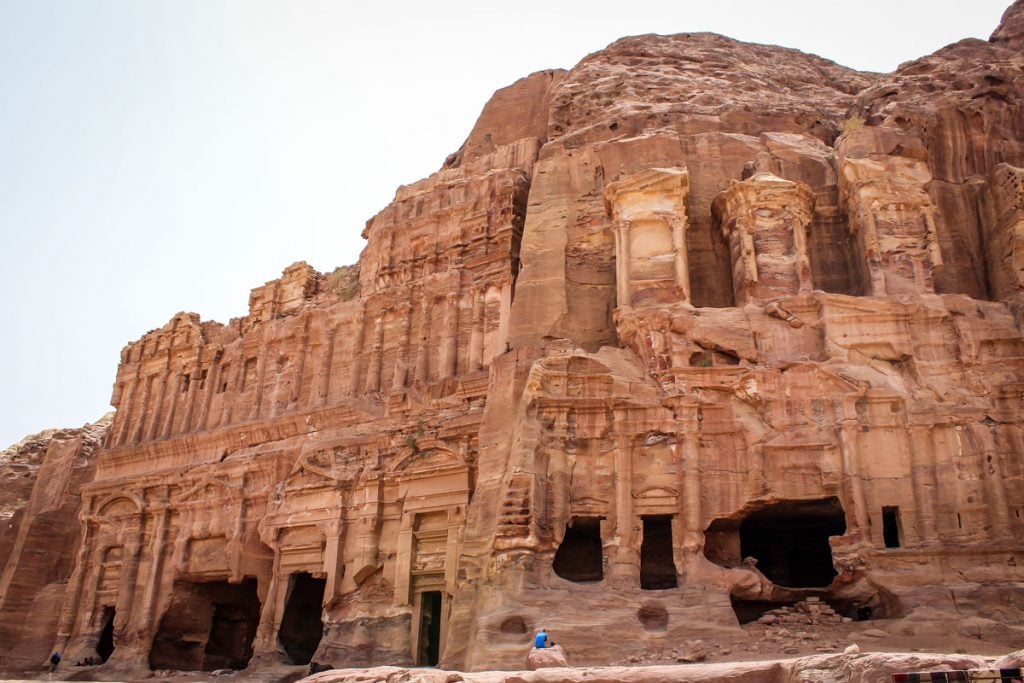
The postcard-worthy mausoleums known as The Royal Tombs were impressively chiseled right into the western face of the Jabal al Khubtha cliffs. Archaeologists don’t have any evidence directly linking these tombs with specific Nabataean rulers, but they generally agree that they serve the royal family.
Similar to the Treasury, the Royal Tombs feature jaw-dropping facades that include intricately-detailed Corinthian columns and other architectural embellishments.
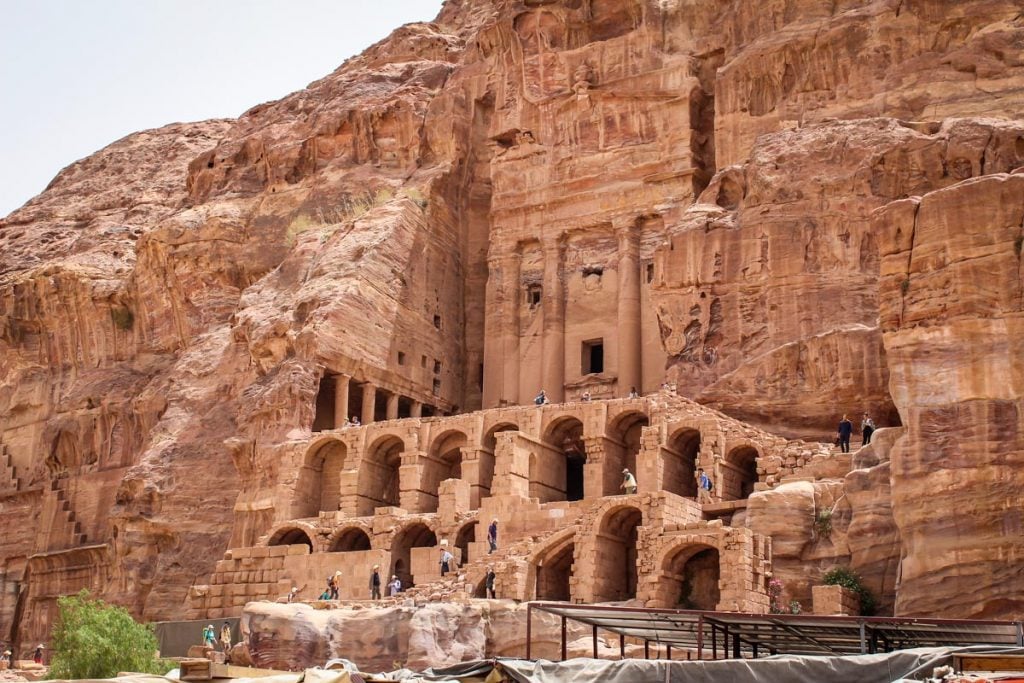
The Urn Tomb is particularly noteworthy, with several striking features. There are two stories worth of arches, as well as a massive courtyard (seriously, photos do not do the size of this structure justice!). Views over the entire city are spectacular from this spot.
Insider travel tip: A good time to visit the Royal Tombs is in the afternoon, around 4:00 p.m., when the majority of Petra visitors have returned to their accommodation to rest and the place is nearly deserted! The sun will also be in the best position to highlight the west-facing tombs.
4. Climb to the Petra Monastery
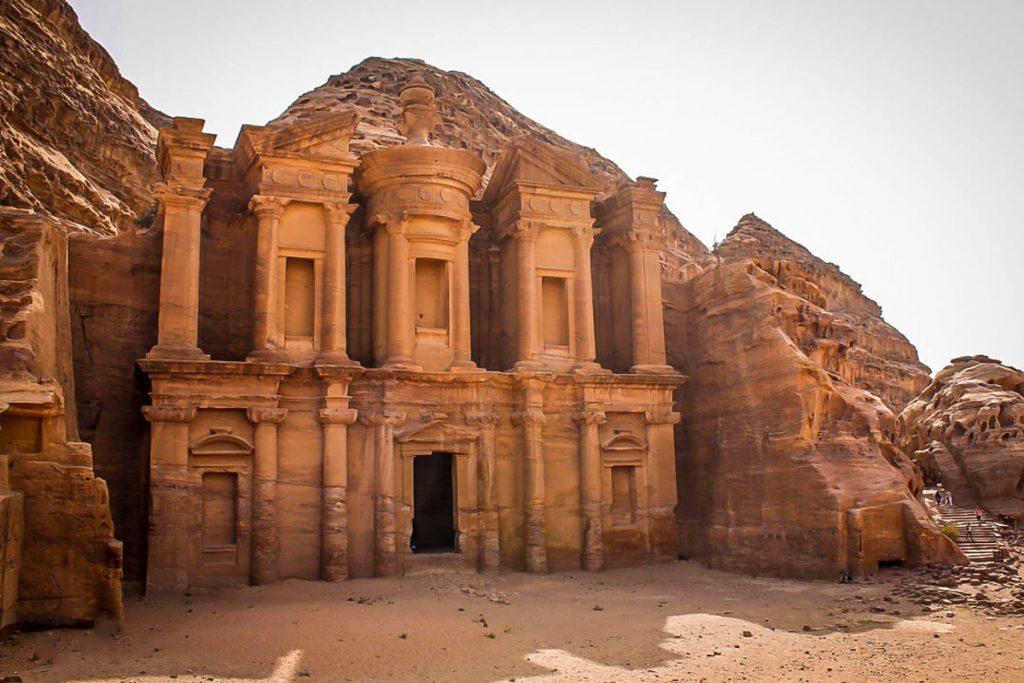
The Monastery (Ad-Deir) is a substantially larger structure than the Treasury. It’s absolutely enormous! It’s not quite as elaborate in terms of detail, but its size is breathtaking and as a bonus, it’s in a slightly less-accessible location. (Hint: Less accessible = fewer people!)
Getting to the Monastery requires a serious climb of 800 steps. For those of moderate fitness levels who hike or exercise somewhat regularly, plan on it taking approximately 1.5-2 hours.
If you can reach the base of the staircase by around 10:00 a.m., you’ll hike up mostly in the shade and escape the worst of the heat. Keep in mind, though, you’ll still have to come back down while the sun is at its strongest.
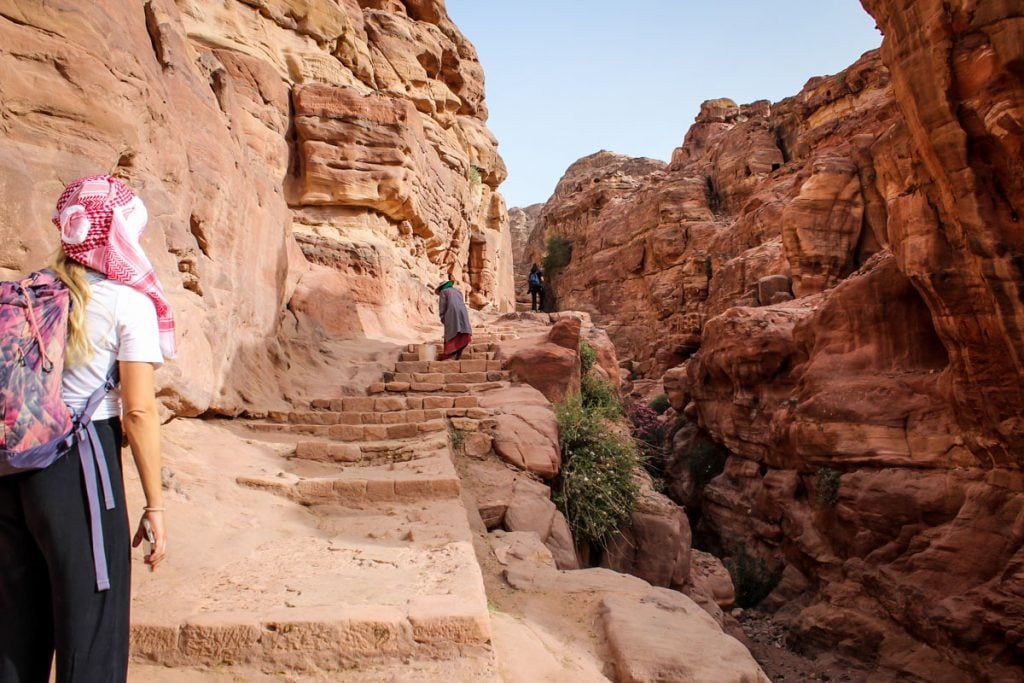
If you’re up for a bit of a sweaty climb, the Monastery is a worthwhile addition to your itinerary when you visit Petra. The monument itself is a wonder, but its isolated setting against the backdrop of mountains is extraordinary.
Wander around the area and you’ll find epic panorama after epic panorama, looking out over the city and surrounding landscape! There’s a restroom at the base of the steps and a cafe at the summit, so you can have a snack and relax.
Insider travel tip: Immediately after visiting the Treasury and the High Place first thing in the morning, head straight to climb the steps to the Monastery. You’ll beat the crowds (who are just starting to fill in at the Treasury around 8:00 a.m.) to the Monastery, enjoying it mostly to yourself.
5. Venture to Little Petra
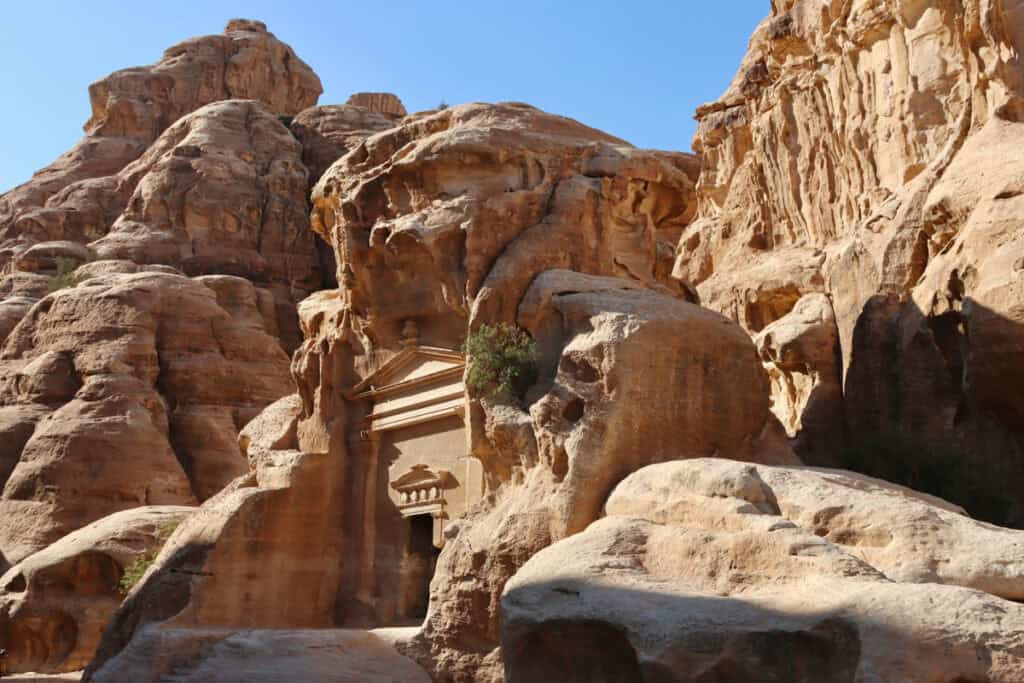
Little Petra is a smaller archaeological site just a few kilometers north of the Petra Archeological Park. Also called Siq al-Barid, Little Petra is not as famous or as visited as its big sister, and is completely free to enter.
The site features a narrow, rock-carved canyon leading to a series of ancient structures, including tombs, temples, and triclinia, which were used for dining and social gatherings.
Unlike the bustling main Petra site, Little Petra provides a more intimate experience for exploration with fewer crowds.
6. Marvel at the Great Temple
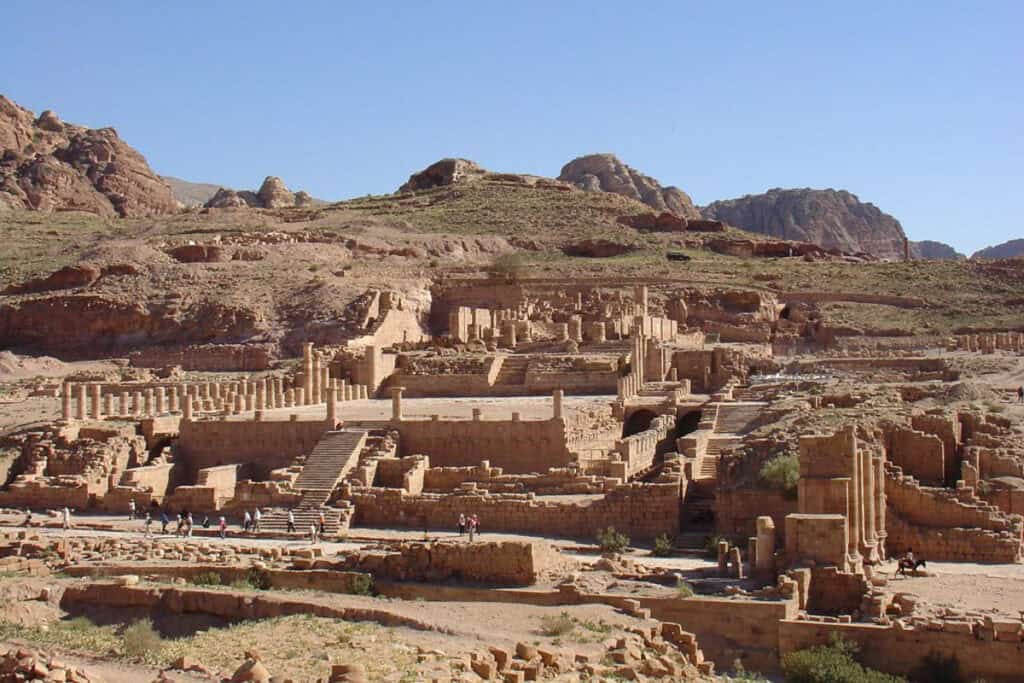
The Great Temple of Petra is a monumental architectural complex that stands as one of the most significant structures within the ancient city. Believed to have been constructed in the first century BCE, the Great Temple offers a reflection of the sophisticated engineering capabilities of the Nabataeans.
Spanning an area of approximately 7,560 square meters, the temple complex includes detailed carvings, great halls, staircases, expansive courtyards and the remnants of vibrant frescoes.
7. Walk the Siq
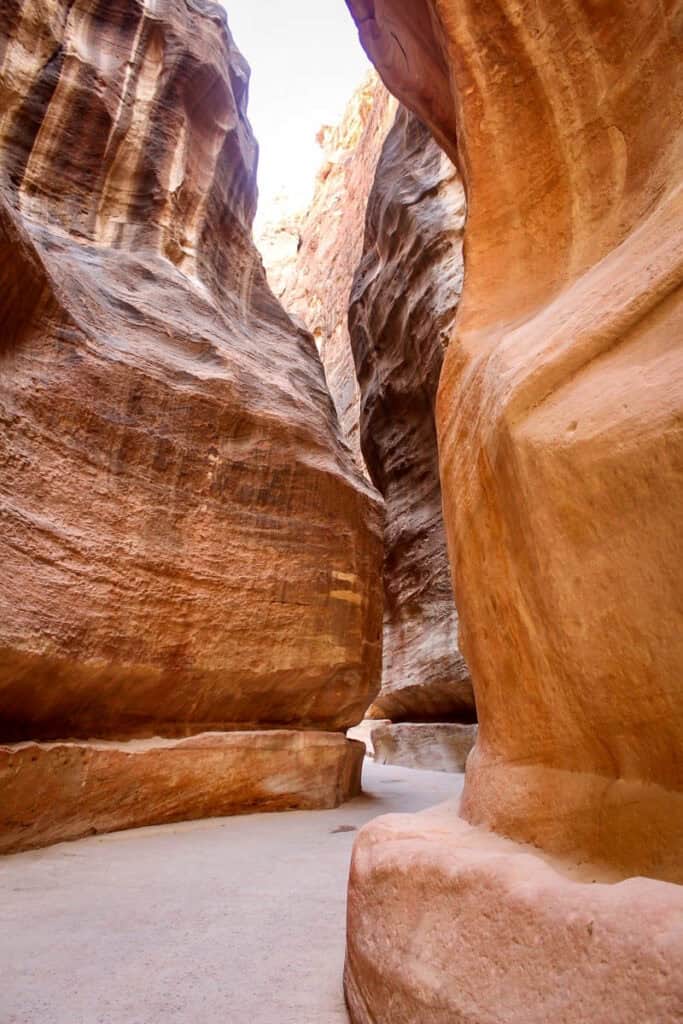
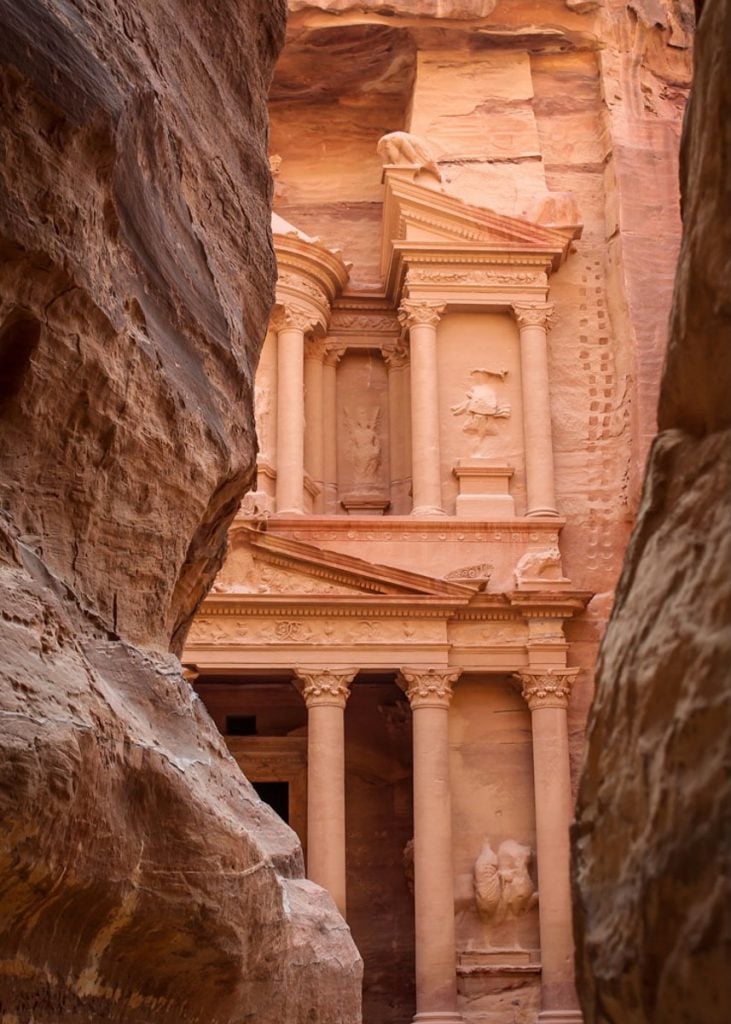
The Siq is a dramatic passageway through a narrow gorge, stretching approximately 1.2 kilometers, that serves as the main entrance to the ancient city of Petra.
It takes around 30 minutes to walk from Petra’s main entrance to the Treasury along the Siq as it winds through stunning rock formations, flanked by towering cliffs that reach up to 80 meters high.
The walk showcases remnants of ancient carvings, water channels, and niches, offering a sense of awe and anticipation as you make your way to the iconic Treasury.
8. Experience Petra By Night
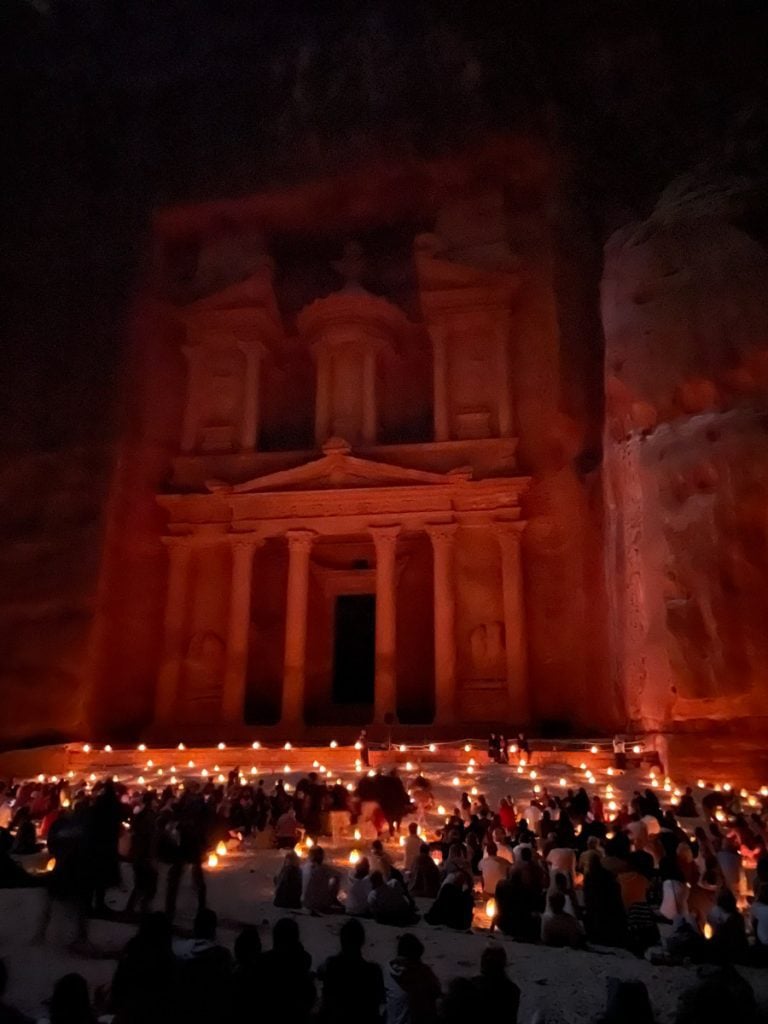
To see the first rays of the morning sun light up the chiseled details of the Treasury is one thing, but experiencing Petra at night is a whole different experience. You’ll be able to see Petra illuminated by hundreds of small candles, a truly magical experience.
There are a few things to keep in mind before planning your visit, mainly being that the night experience only runs on Mondays, Wednesdays, and Thursdays, and is a separate ticket from your Petra entrance ticket (and not included in your Jordan Pass). You’ll have to pay an additional 17 JOD for this experience.
Gather up your preferred photography gear and read up on our detailed guide to Petra at Night that you’ll definitely find useful for planning your late night venture.
9. Discover Petra Church
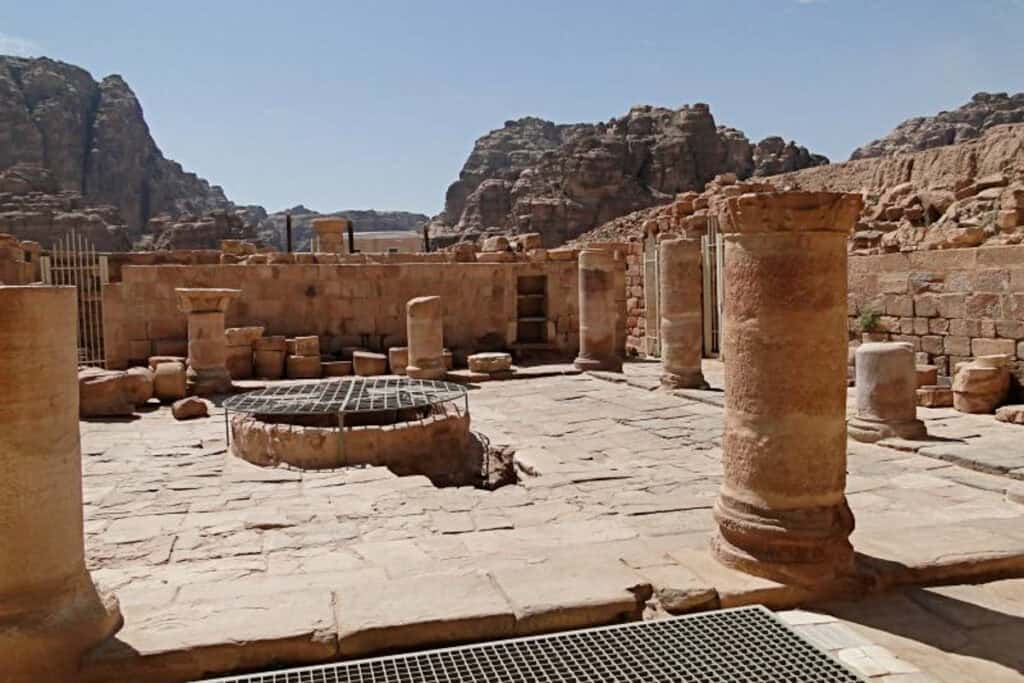
Petra Church, also known as the Byzantine Church, is a significant archaeological site from the 5th century AD within the Petra Archaeological Park.
Notable for its well-preserved mosaics depicting flora, fauna, and geometric patterns. The complex includes a baptistery, courtyard, and additional rooms, highlighting its role as a religious and community center.
Excavations have also revealed carbonized scrolls, offering valuable historical insights, making Petra Church a key site for understanding the city’s diverse history.
10. Street of Facades
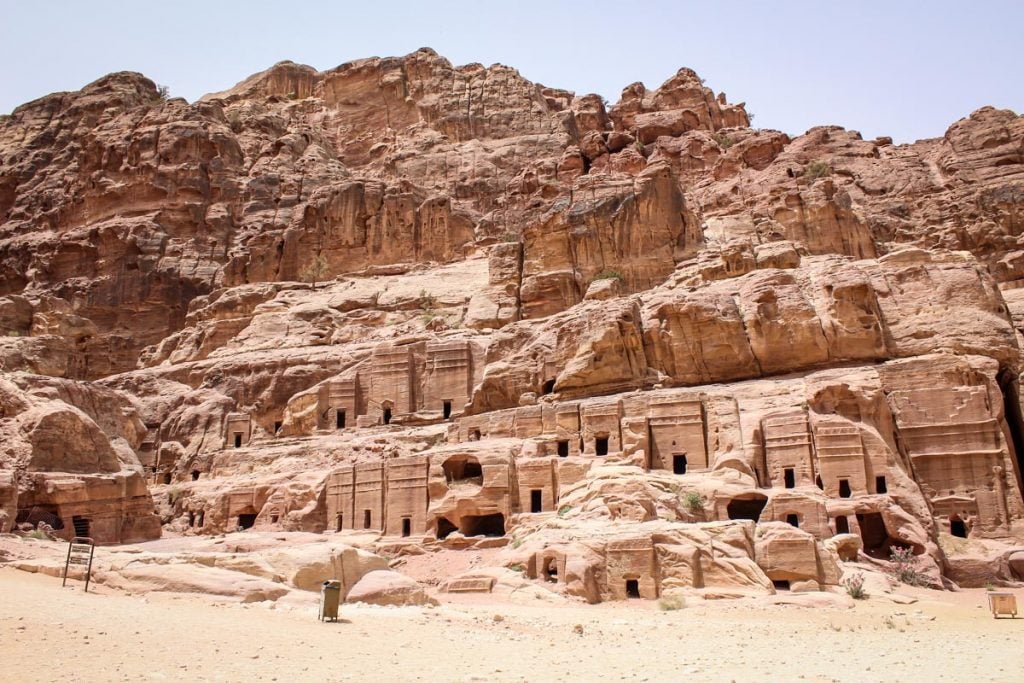
Leaving the Treasury, you’ll stroll along the Street of Facades (not really much of a street as it is a wide and sandy pathway) on your way to the Royal Tombs.
The “street” is lined with numerous rock-cut tombs and monuments featuring elaborate Nabataean architecture. These facades, with varying designs and intricate carvings, showcase the wealth and artistry of Petra’s ancient inhabitants.
11. Petra Theater
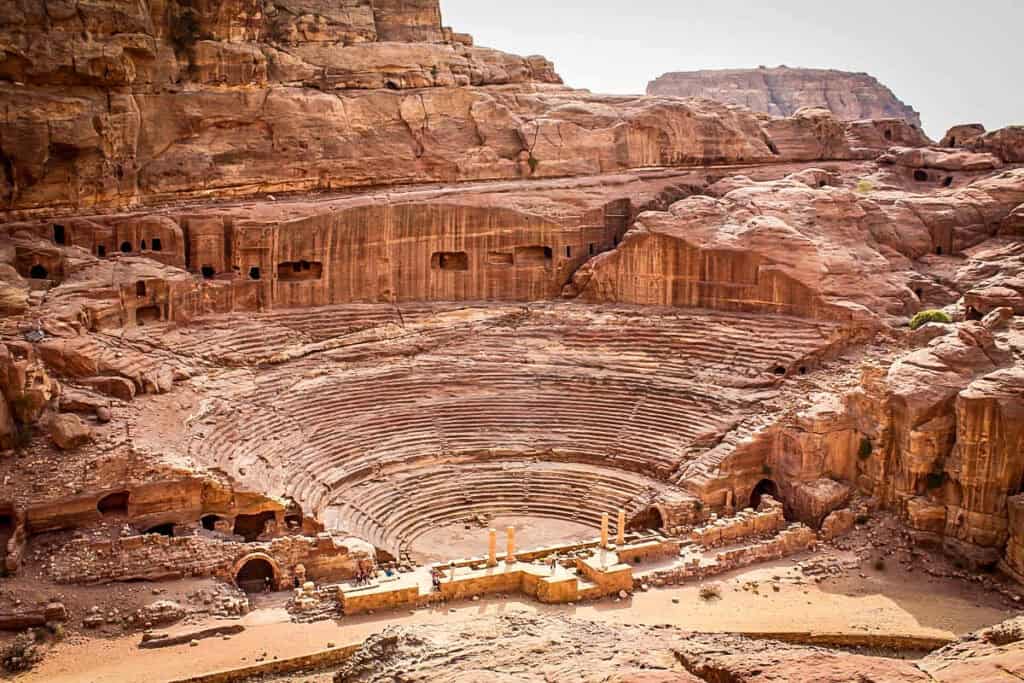
A grand ancient amphitheater carved directly into the rose-red rock in the center of the complex, has been dubbed the Petra Theater.
Reflecting a blend of Nabataean and Roman architectural styles, the theater’s semi-circular design and tiered seating highlight its importance as a cultural and entertainment hub in ancient Petra.
This impressive structure, capable of seating up to 8,500 spectators, underscores the city’s historical significance and the advanced engineering skills of its builders.
12. Make your way down the Colonnaded Street
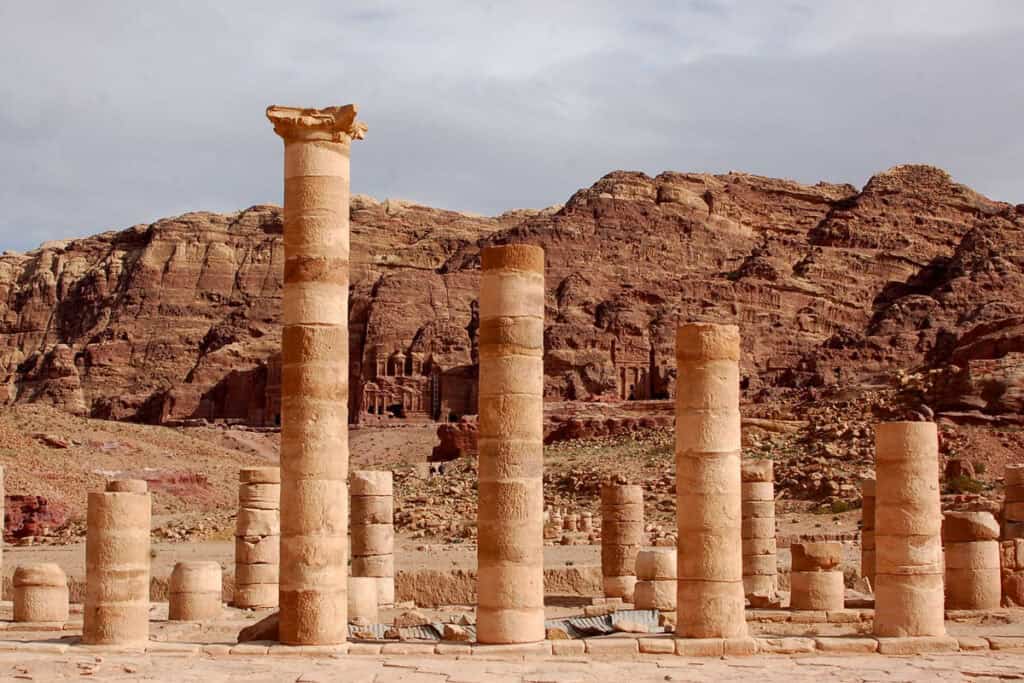
Beyond the Royal Tombs and on your way to the base of the climb to the Monastery, you will have to pass by the Colonnaded Street.
This grand street is a significant thoroughfare flanked by well-preserved columns, originally lined with shops and public buildings, showcasing the city’s urban planning and commercial activity.
The Colonnaded Street, which reflects Roman influence, connects major sites such as the Great Temple and the Petra Church, underscoring Petra’s role as a bustling trade center.
13. Go back in time at the Petra Museum
History buffs will appreciate a visit to the Petra Museum, a modern cultural institution dedicated to preserving and showcasing Petra’s rich archaeological heritage.
The museum, which is located near the entrance of the ancient city, features a diverse collection of artifacts, including pottery, sculptures, and tools, that chronicle the history and daily life of the Nabataeans.
Interactive exhibits and detailed displays provide visitors with a comprehensive understanding of Petra’s development, trade, and cultural significance. A visit to the Petra Museum will surely enhance your experience of the historic site.
14. Have a drink at the Cave Bar
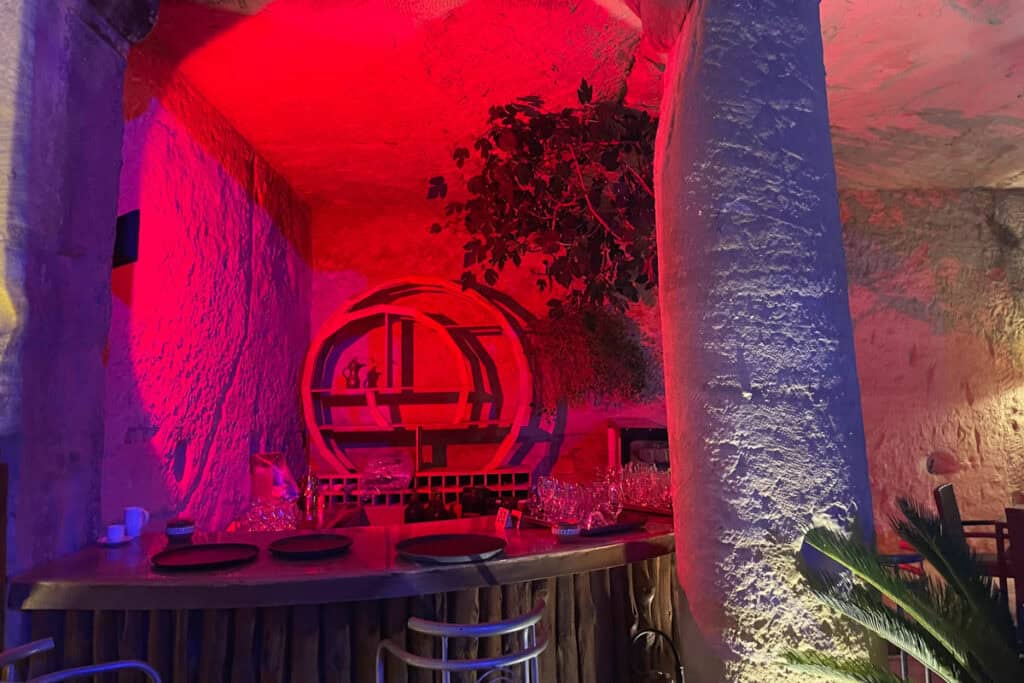
The Cave Bar is a 2000 year old cave-turned-wine-bar on the property of the Petra Guest House Hotel, which sits within the entrance to the Petra Complex.
Even if you’re not staying there, it’s a great place to grab a drink in a seriously unique atmosphere.
This one made our list of best things to do in Petra because it’s actually just inside the entrance to the Petra complex.
15. Take a cooking class at Petra Kitchen
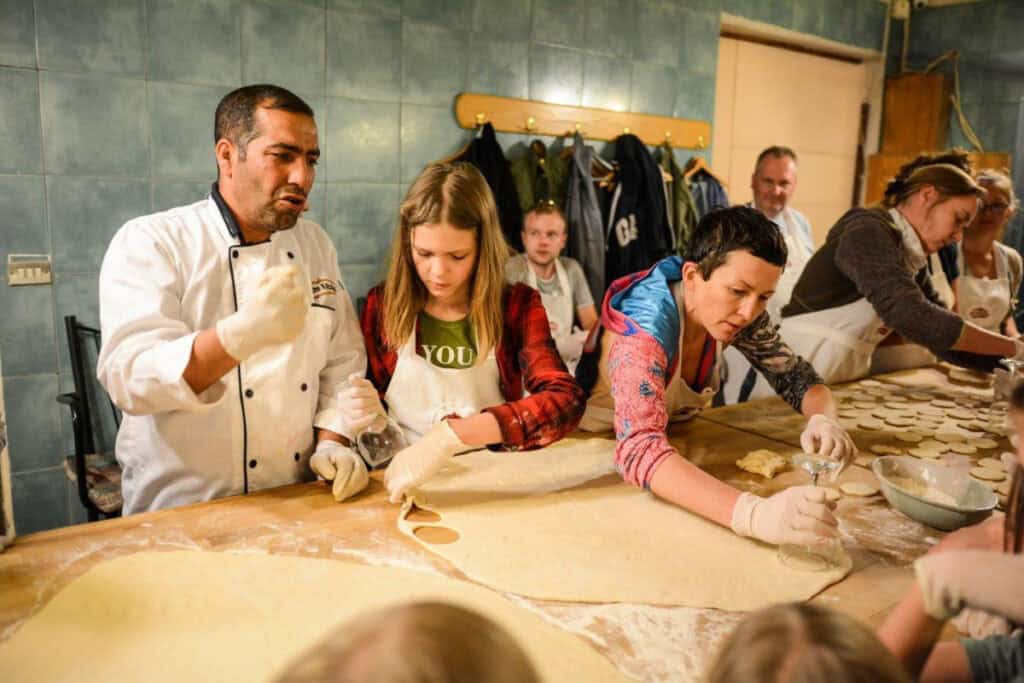
Petra Kitchen offers nightly cooking classes in a uniquely Jordanian experience. You will work alongside local chefs to learn how to prepare typical Levantine dishes using fresh ingredients.
Each night the class prepares a multi-course menu. You will then get to share the meal with the other guests as you swap travel stories and learn more about Jordanian culture from your local chefs.
Classes are held nightly at 6:30 p.m. (Mar – Oct) and 6:00 p.m. (Nov – Feb). The cost is 35 JOD per person (~$50 USD) and you can reserve your spot online.
While not in the Petra Archaeological Park itself, we included this activity as it seems like a fun and unique thing to do in the area while you are visiting Petra.
Is Petra worth visiting?
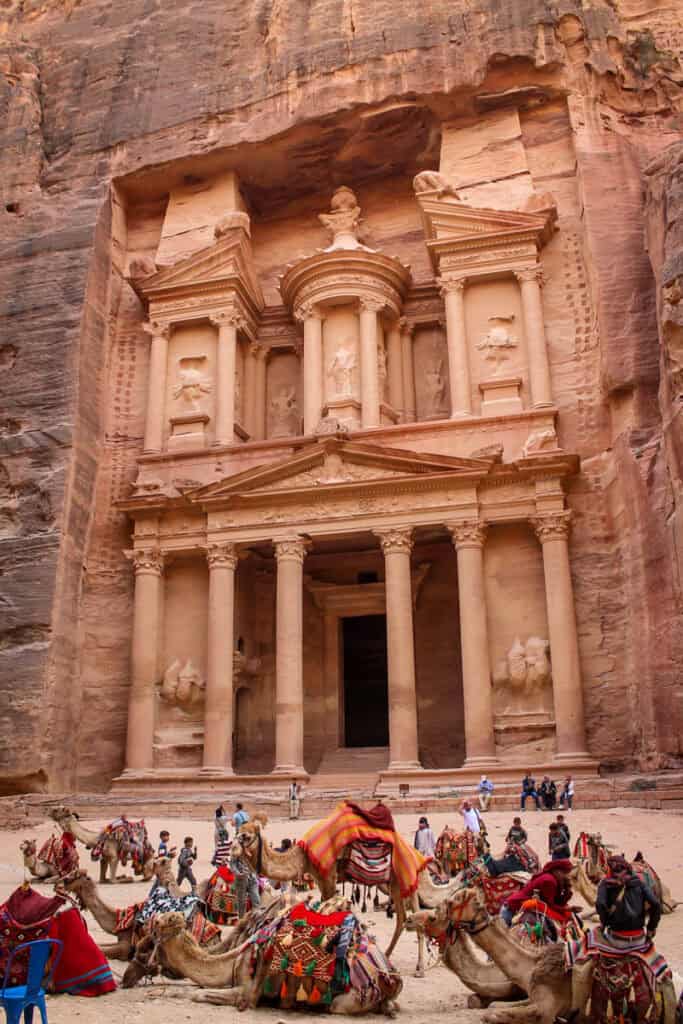
As one of the most popular destinations in the Middle East, Petra is 100% worth visiting! The “Lost” Nabatean City was carved directly into the sandstone cliff faces and comprises beautifully-preserved buildings in hues of rose, orange, and red (hence, Petra’s well-deserved nickname, “the Pink City”).
Experiencing the unique history, culture, architecture, and landscapes of this prehistoric city is absolutely thrilling and exploring Petra feels like a true expedition!
General Info
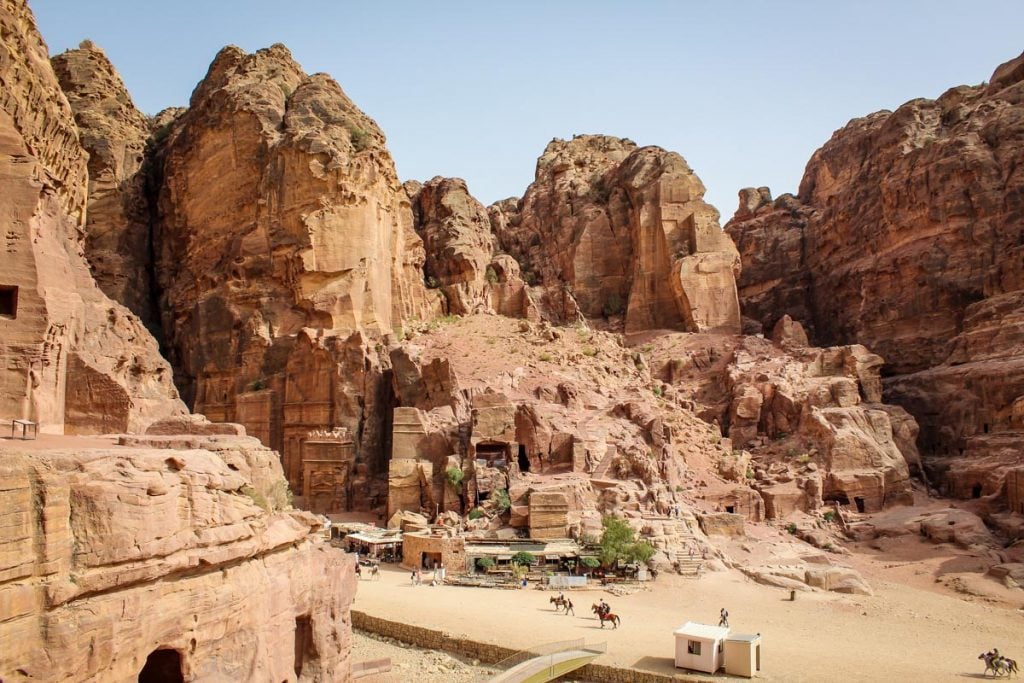
Here is all the info you need to visit Petra at a glance.
- Location: The only public entrance is through the Petra Visitors Center in Wadi Musa, Jordan
- Hours: 6:00 am to 6:00 pm during the summer and 6:00 am to 4:00 pm in the winter
- Cost: From 50 JOD ($70 USD)
- Reservations: None required
- Area: 102 square miles (264 square km)
How to get to Petra
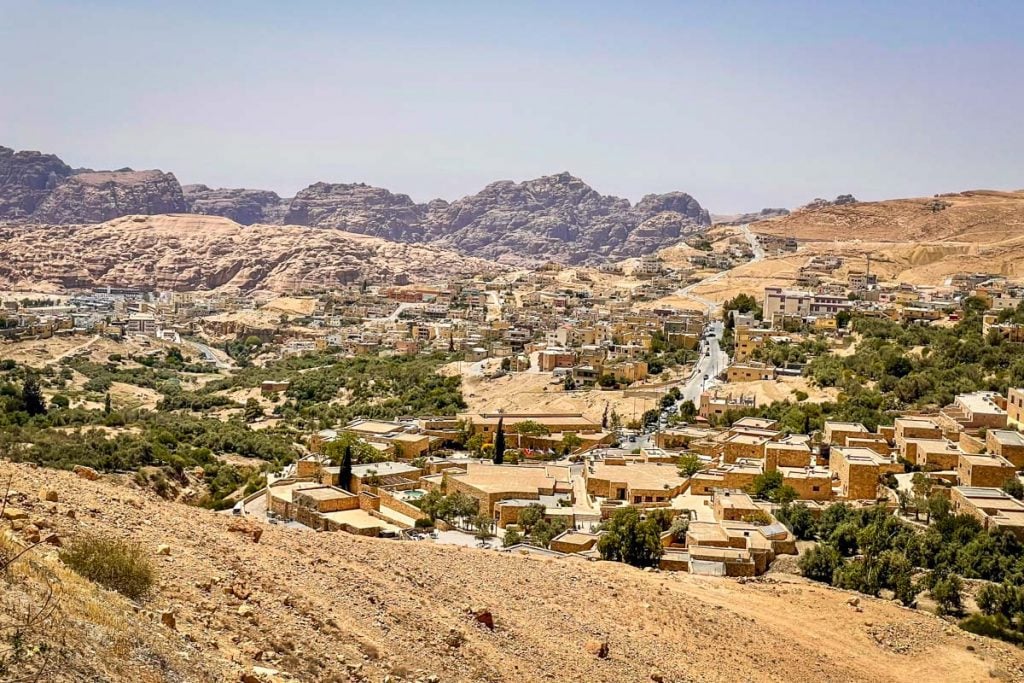
You’ll likely start your Petra trip from either Amman, Jordan’s capital city, or the coastal resort city Aqaba. From either origin, you can rent a car, hire a private driver, or use public transportation to connect to Wadi Musa—the gateway to Petra.
Amman is 143 miles (230 km) north of Petra, home of the Amman International Airport (AMM). There are several options for transportation between the two cities, and we have a detailed guide on how to travel from Amman to Petra which outlines all of your options.
Aqaba is 78 miles (125 kilometers) southwest of Wadi Musa – a 2-hour drive via the Desert Highway. Coming from this direction, the Jordan Valley Highway takes about an hour longer but is much more impressive visually.
Tourist buses operated by JETT travel the Desert Highway from both origin points. They depart Amman daily at 6:30 a.m. with a trip time of three hours, and from Aqaba every day at 8:00 a.m., with a 2.5-hour drive time.
If you prefer to visit Petra via tourist bus, you can book tickets online in advance via the JETT website or ask your hotel to arrange for you.
Psst! If you’re flying into or out of Amman, don’t skip this underrated city! We put together a guide to the best things to do in Amman to help you plan your stay.
What airport do you fly into for Petra?
The closest airports for getting to Petra are located in Amman and Aqaba.
Amman’s Queen Alia International Airport (AMM) is 126 miles/203 km north of Wadi Musa, while Aqaba’s King Hussein International Airport (AQJ) is located 83 miles/133 km southwest of the city.
Can tourists enter Petra?
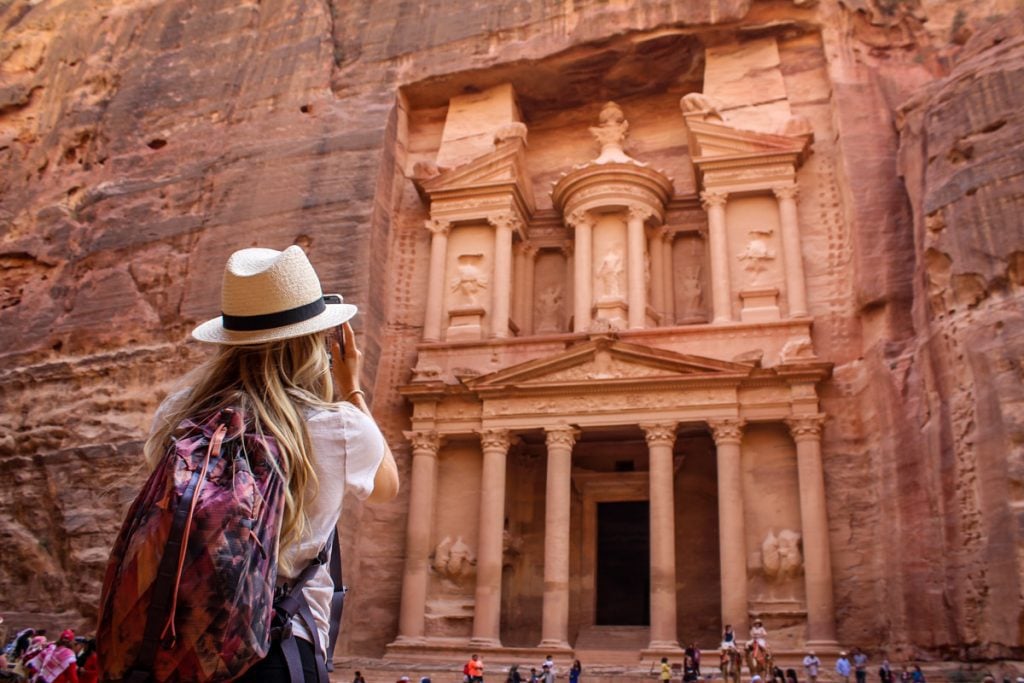
Absolutely! The Lost City is Jordan’s number one attraction — and you should make it your priority to visit Petra and marvel at this ancient, truly unique site with your own eyes.
There are well-trodden paths throughout the site to bring you to all of the ancient ruins. Some of the ruins, like the Royal Tombs, you can actually go inside and some, like the Treasury and Monastery, are just to marvel at from the outside.
Within the site there are also cafes, snack shops, restaurants and restroom facilities, so you can easily spend an entire day inside.
How much does it cost to visit Petra?
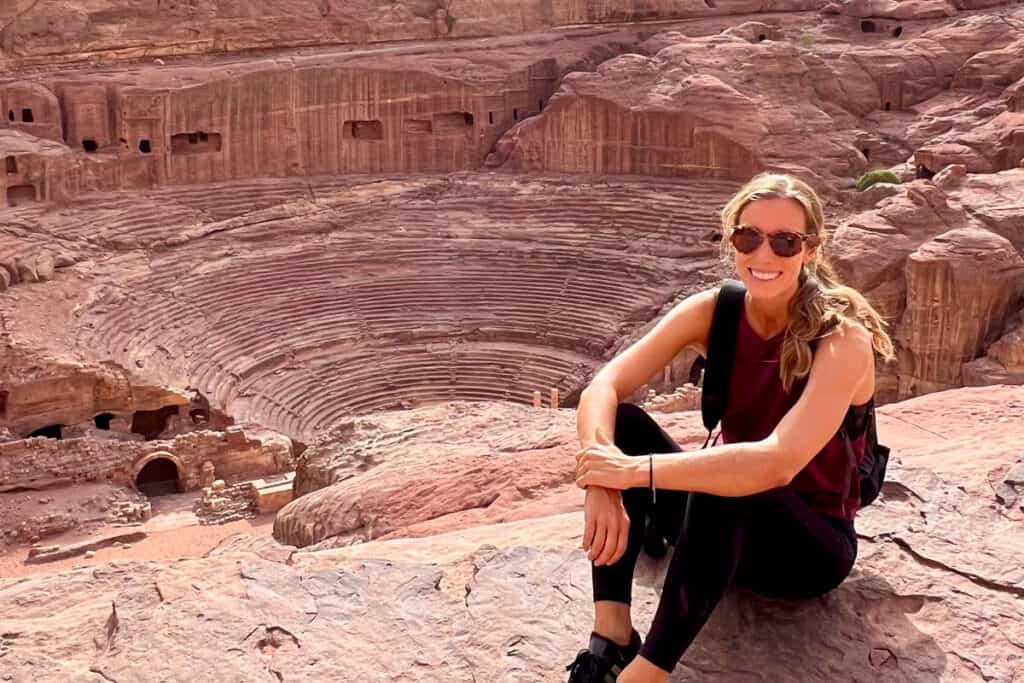
You can purchase tickets to visit Petra at the entrance for the following rates:
- 1 day: 50 JOD (~$70 USD)
- 2 days: 55 JOD (~$78 USD)
- 3 days: 60 JOD (~$85 USD)
If you’re planning to visit Petra without a tour group, spending at least 3 nights in Jordan and eligible for a visa on arrival, we’d highly recommend saving money by purchasing a Jordan Pass.
Admission to Petra is included in the Jordan Pass, which saves you money on visa fees and grants you access to over 40 other sites and attractions around the country. It’s well worth the cost even if you just visit Petra for a single day.
Check out our guide to the Jordan Pass to find out how it can save you money and if it’s the best option for your trip to Jordan.
If you plan to visit Petra with the Jordan Pass, you’ll need to swing by the Ticket Office in the Petra Visitors Center before you can enter the site. They’ll scan your pass and give you physical tickets that you’ll need to enter the site.
Make sure not to lose these tickets if you purchased more than one day in Petra as you’ll need to show the physical ticket each day for entry!
What is the best time to visit Petra?
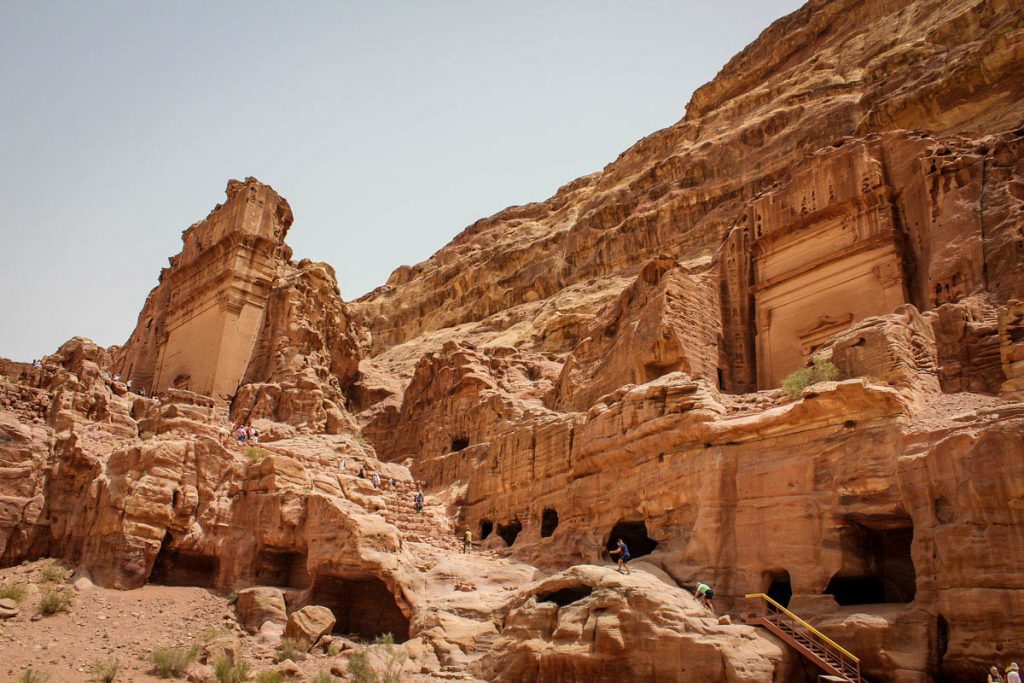
The best time of year to visit Petra is during the spring (March – May) and fall (September – November). Cooler temperatures with significantly less chance of rain make it an overall more pleasant experience.
Of course, everyone else knows this, too, so spring and fall are busy in Petra. Summer and winter see far fewer crowds, but the downside in both seasons is the weather. Temperatures in the summer can soar above 100°F (about 40°C), while the winters are rainy and cold.
Psst! For an in-depth guide on the regional seasons, weather patterns and other factors, check out our complete guide on the best time to visit Jordan.
Best time of day to visit Petra
No matter what time of year you visit Petra, plan to arrive as early in the morning as possible before 8:00 a.m., and/or later in the evening after 3:00 p.m. This spares you the sweltering midday heat, overhead sun, and most of the crowds.
During my visit, my friend and I woke up at the crack of dawn and reached the entrance at opening time, promptly at 6 a.m. (highly recommended!). We shared the site with just a few other early risers until about 8 a.m., when foot traffic picked up.
By 10:30-11 a.m., crowds are heavy and the sun moves into a position directly overhead, casting glare to a point that lighting isn’t very good for photos.
In contrast, late afternoon is another nice time to visit Petra. Most of the crowds have dispersed by about 3:30 p.m. and by 4:00 p.m., it’s relatively quiet. Keep in mind the site closes at 6:00 p.m. so if you arrive later in the afternoon, you won’t have time to make it all the way to the Monastery and back before closing.
How many days do you need in Petra?
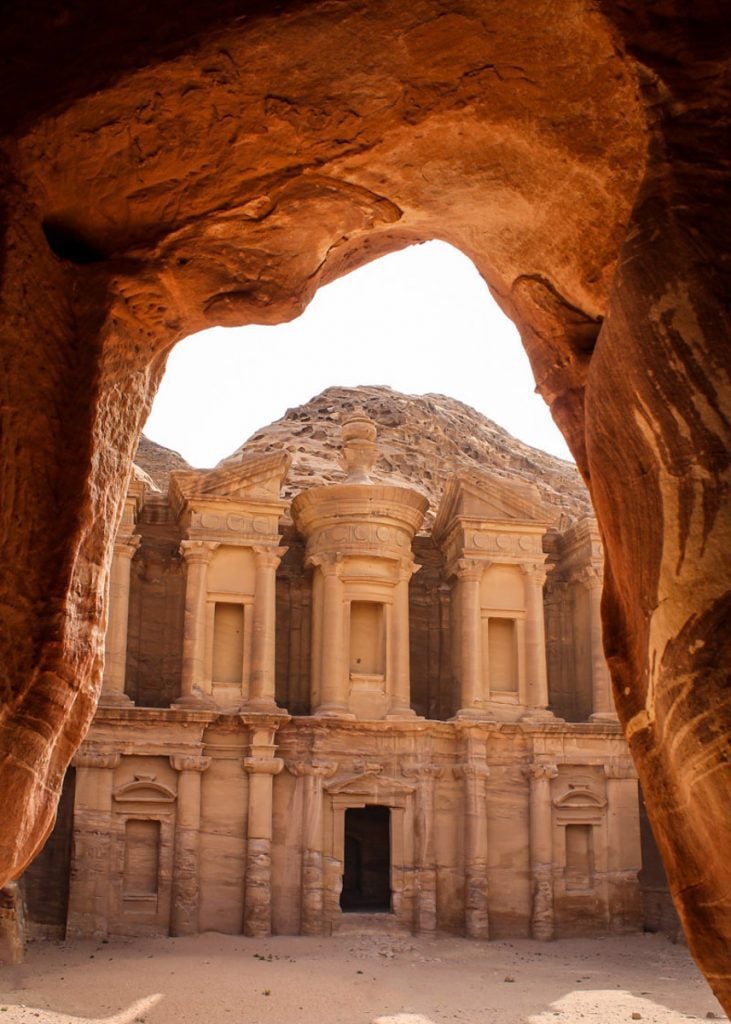
In my opinion, two days is an ideal amount of time to visit Petra. This allows you to see all the major points of interest without having to rush. Technically, you can squeeze in all four spots listed above in a single day, but it will be a long, exhausting day moving at a faster pace than we recommend.
If you cannot manage 2 full days in Petra, I’d recommend visiting in the late afternoon on your first day and first thing in the morning on your second day to make the most of your time there.
Psst! If you’ll be moving on after Petra, be sure to check out our transportation guide for how to get from Petra to Wadi Rum to take the guess work out of your logistical planning.
Petra itinerary planning
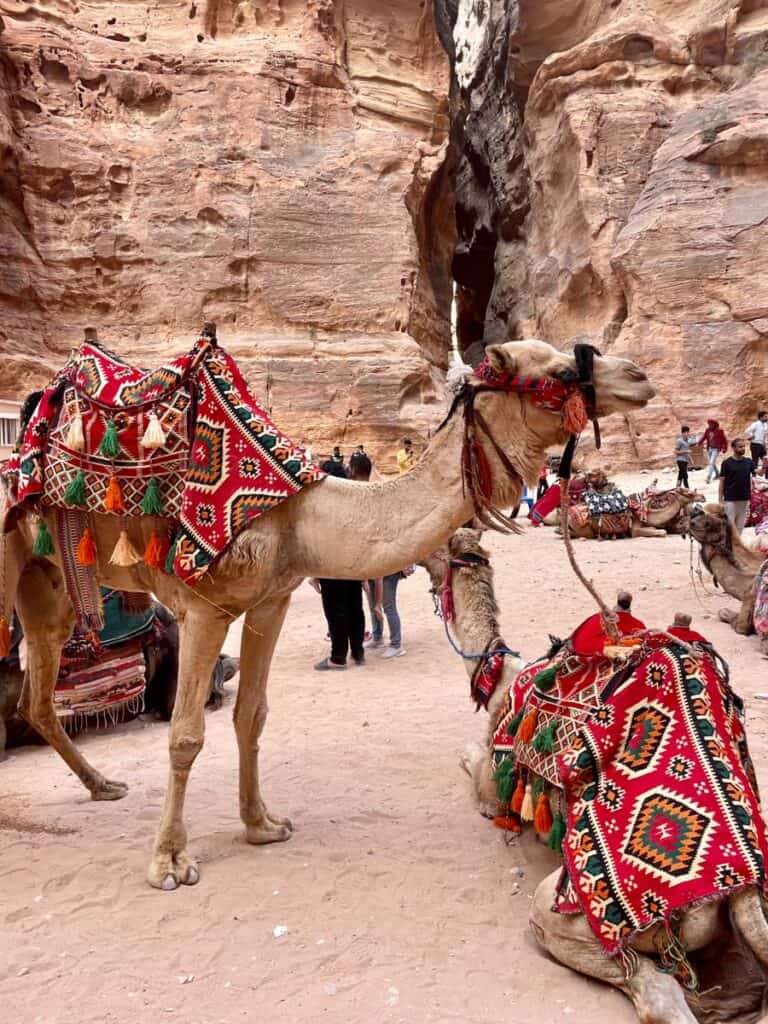
With the Jordan Pass, you will be allowed 1, 2, or 3 days entrance to the ancient city of Petra. We’d highly recommend going for at least 2 days.
On your first day in Petra, you may be traveling in the morning so you’ll arrive later in the afternoon. We actually think this is a great way to get a taste of the complex, at a time of day when most visitors have gone.
You’ll walk the Siq trail, see the Treasury (and maybe even climb to The High Place if you have the energy), and walk through the main complex to check out the Royal Tombs, Great Temple, Byzantine Church, Theater and Colonnaded Street.
On your second morning, be sure to get there right when the gates open at 6:00 a.m. Trust me, you won’t regret it once you’ve had The Treasury almost entirely to yourself!
After taking some photos of the Treasury from the various viewpoints, you’ll want to make a bee-line to the Monastery to beat the crowds. As long as you start your climb to the Monastery by 8:00 a.m. you’ll be in good shape.
Be sure to spend some time up near the Monastery and hike up into the hills for some of the best views in all of Petra. After an hour or so the crowds will start filling in and you can make your way back down to the main complex.
You have the rest of the day to decide how you want to continue to explore Petra. If you have to leave by midday to make it to the next stop on your Jordan trip, at least you will have seen the highlights of Petra in the best times of day.
What to wear/pack for visiting Petra
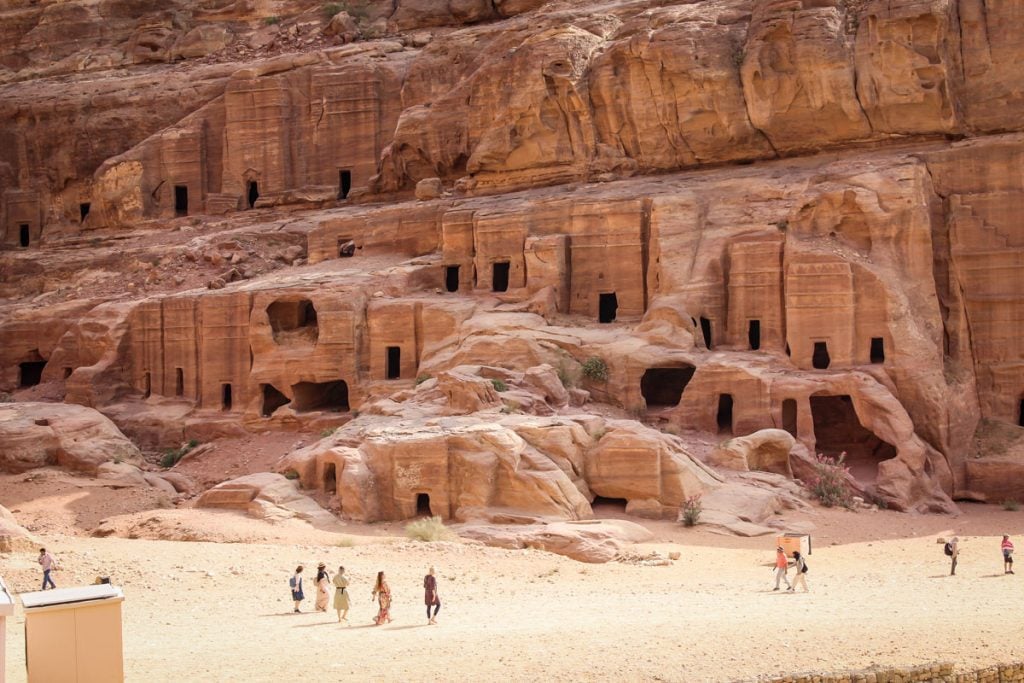
- Modest but breathable clothing: Lightweight, breathable clothing made from non-synthetic fibers.
- Note: While Petra is the one place in the country where you may see women sporting tank tops and short-shorts, due to the heat and overwhelming number of tourists, I still recommend yielding toward modesty to avoid offending anyone.
- Sun protection: Sunscreen, hat and sunglasses are essentials!
- Comfortable footwear: You’ll be doing a ton of walking, so go for comfort over style, trust me!
- Chacos are a great sandal for walking in offering comfort, support and open-toes
- Water bottle: Packing a reusable water bottle is the best way to stay hydrated while exploring Petra, without adding to plastic waste.
- Snacks: It’s always a good idea to have a few light snacks with you in case you get hungry while exploring.
- Note: There are dozens of food vendors inside the city, and even a few sit-down restaurants where you can also refill your water bottle.
- Camera and tripod: Trust me, you won’t want to come all the way to Petra without a means to capture the memories!
- Joby makes our favorite travel tripods that are small enough to pack in your day pack, handheld, and with flexible leg that can latch onto anything.
Where to stay to visit Petra
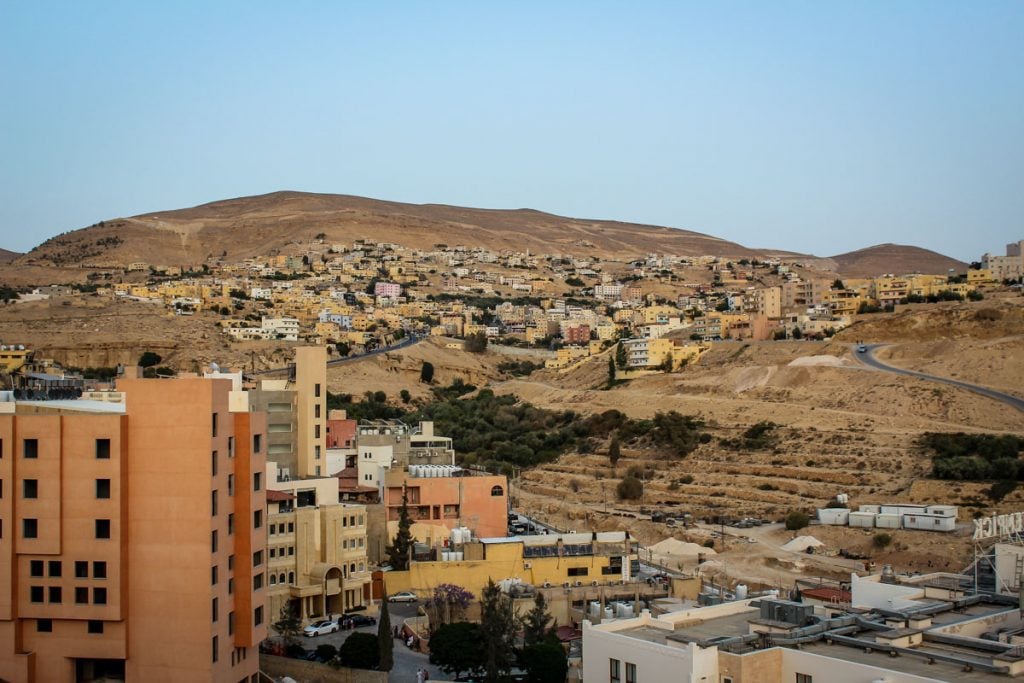
In terms of where to stay to visit Petra, the town of Wadi Musa is the most convenient. Truthfully, it’s not much more than a tourist-focused gateway to the ancient city, so there isn’t a ton of difference between the main hotels.
It does make a huge difference, though, if you choose accommodation within walking distance of Petra’s entrance. This will spare you the high costs of either parking a vehicle or taking taxis.
Hotels near Petra
We recommend three hotels near Petra, and they’re all very similar in several regards. All are easily walkable to the entrance, have near-identical amenities, and are priced similarly.
As a pleasant bonus, accommodations in Jordan are relatively inexpensive in comparison to, well, just about everything else!
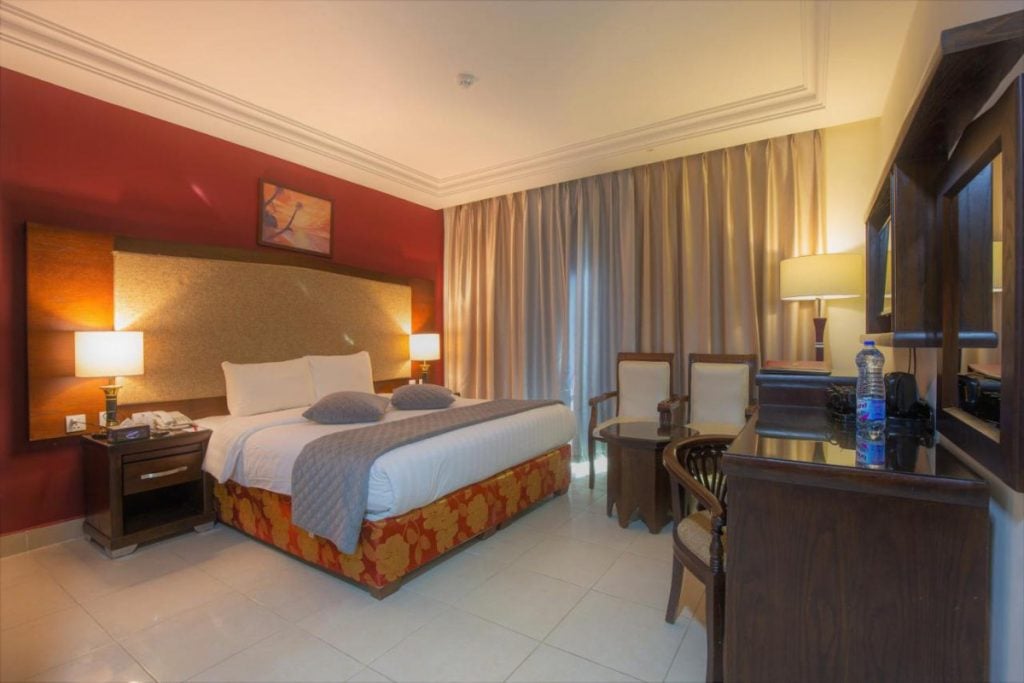
Budget-friendly stay: The Petra Moon Hotel
A decent hotel at an affordable price, just across the street from the Petra Visitor’s Center entrance. The rooms are very much no-frills, but the beds are outrageously comfy and you have in-room temperature control. The dinner buffet deserves a special shoutout; it’s loaded with local and international foods with tons of fresh produce and healthy options!
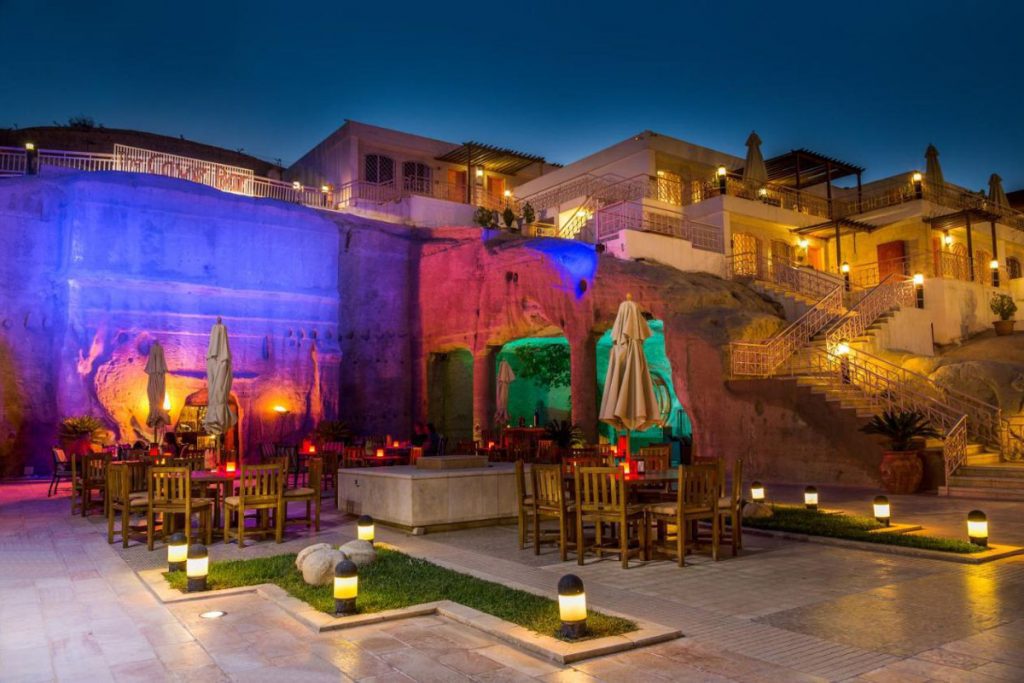
Mid-range/couples’ stay: Petra Guest House Hotel
Situated inside the Petra Visitor’s Center, just before the entrance to the site itself, this 4-star hotel has air-conditioned rooms with en suite bathrooms and high-quality furnishings. Communal exterior spaces include landscaped gardens and a sublime terrace bar with views over the town and mountains. Rates include a very good buffet breakfast and the option to add on dinner.
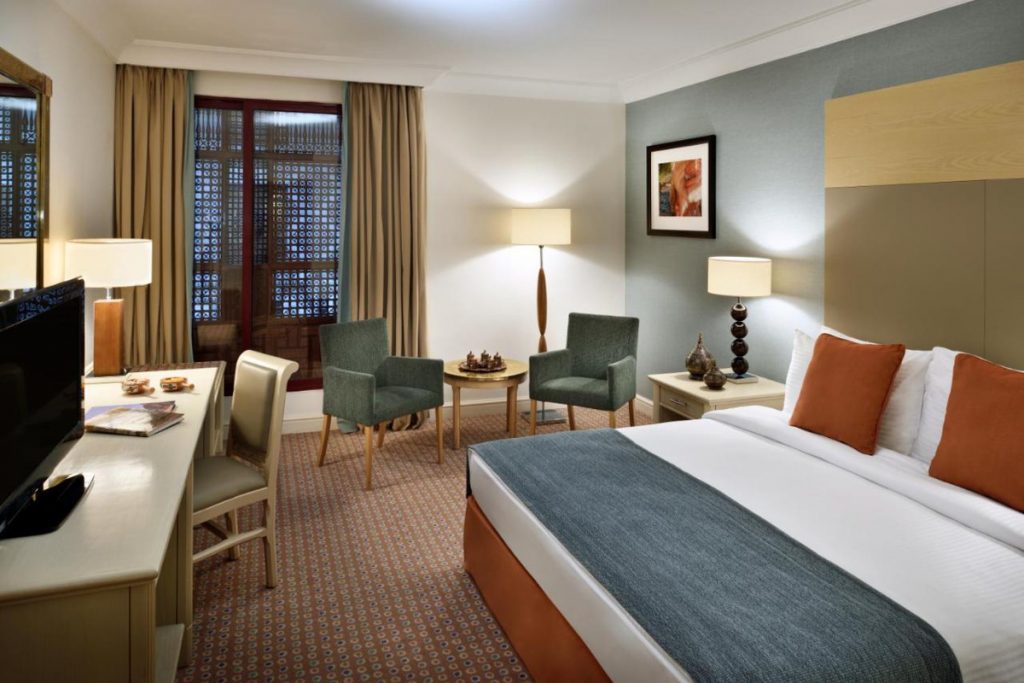
Splurge stay: Mövenpick Resort Petra
Planning to visit Petra for a special occasion? You’ll love this swanky resort with an open-air pool, wellness spa, and rooftop terrace, situated just outside the entrance to the Petra Visitor’s Center. The guest rooms are clean, comfortable, and practical, while suites come with plush, roomy salons where you can sprawl out after a day of sightseeing. Breakfast is included, and you absolutely must make time for a cocktail in the statement lobby!
Roundup of things to do in Petra
Here’s a recap of all the best things to do in Petra so you can see everything in one place.
- Petra Treasury
- High Place of Sacrifice
- The Royal Tombs
- Petra Monastery
- Little Petra
- Great Temple
- The Siq
- Petra by Night
- Petra Church
- Street of Facades
- Petra Theater
- Colonnaded Street
- Petra Museum
- Cave Bar
- Petra Kitchen cooking class
Are you planning a trip to Jordan?
We have lots of resources on travel in Jordan and destinations throughout the country. Check out our Jordan Travel Homepage for everything you need to know, or read some of our favorite articles below.
- How to Get From Amman to Petra: Transportation Guide
- Jordan Pass: What is It & Do You Really Need It?
- How to Get From Petra to Wadi Rum: Transportation Guide
- Unforgettable Things to Do in Jordan
Save this article on Pinterest for later!

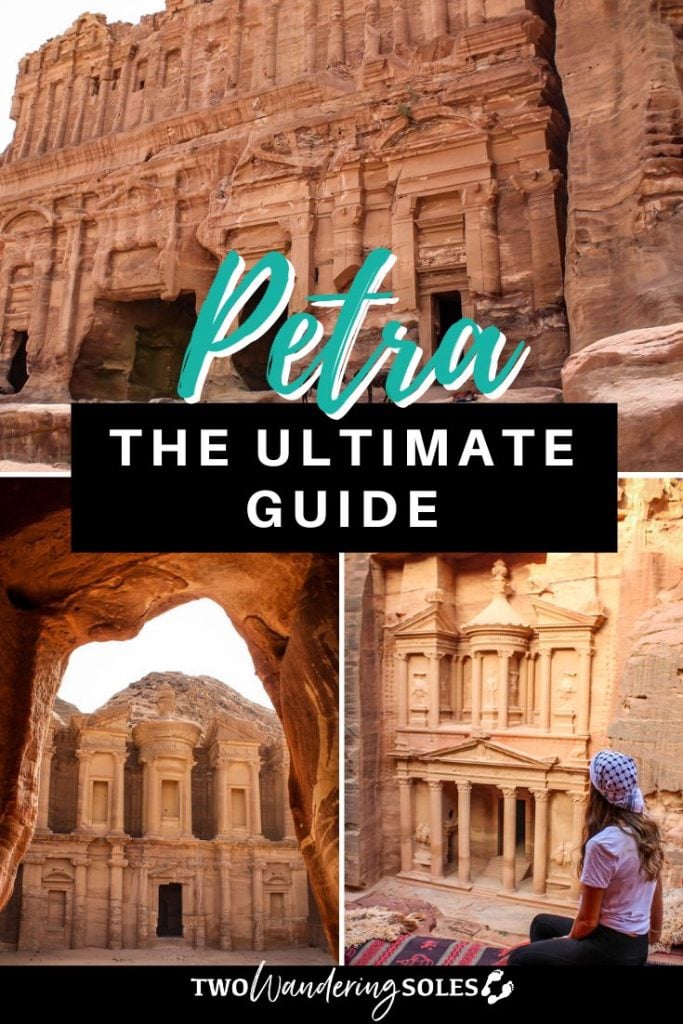
We want to hear from you!
Which of these things to do in Petra are you most excited for? Are you planning a trip to Jordan and still have questions? Leave your comment below and we’ll do our best to get back to you!

This was the best travel blog site on Petra out of over 10-15 reviewed! Thank you, your setup and links are perfect. I thrilled to see what other areas you have covered. Thank you again.